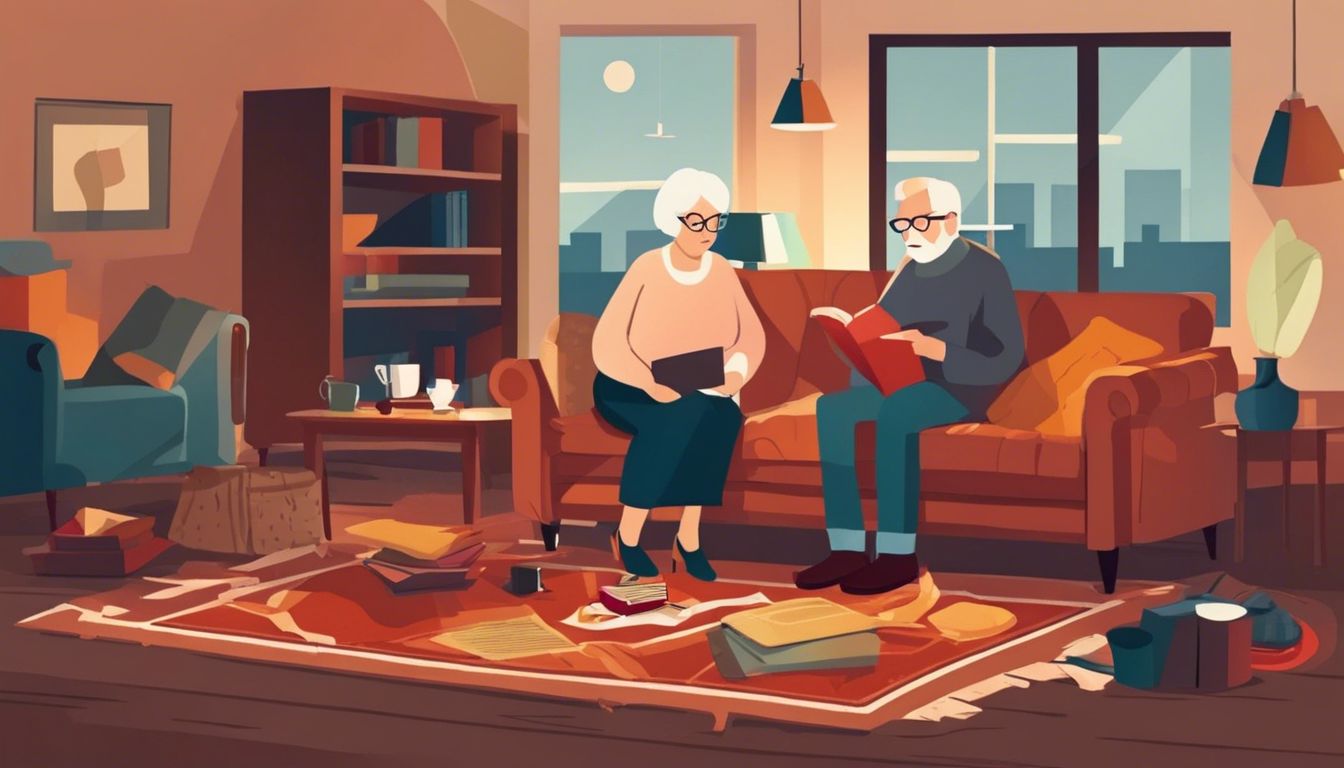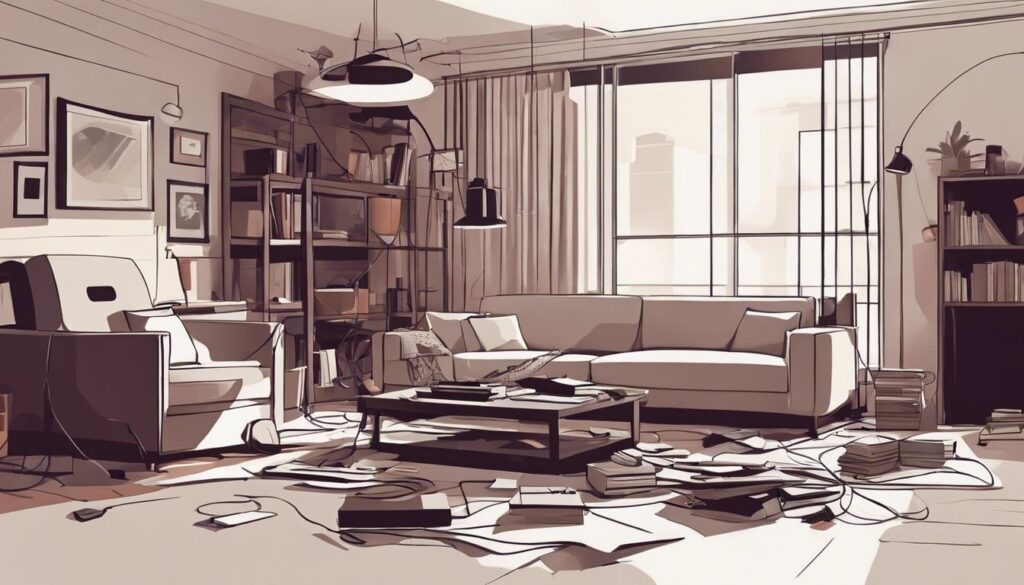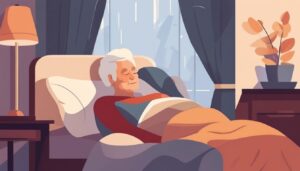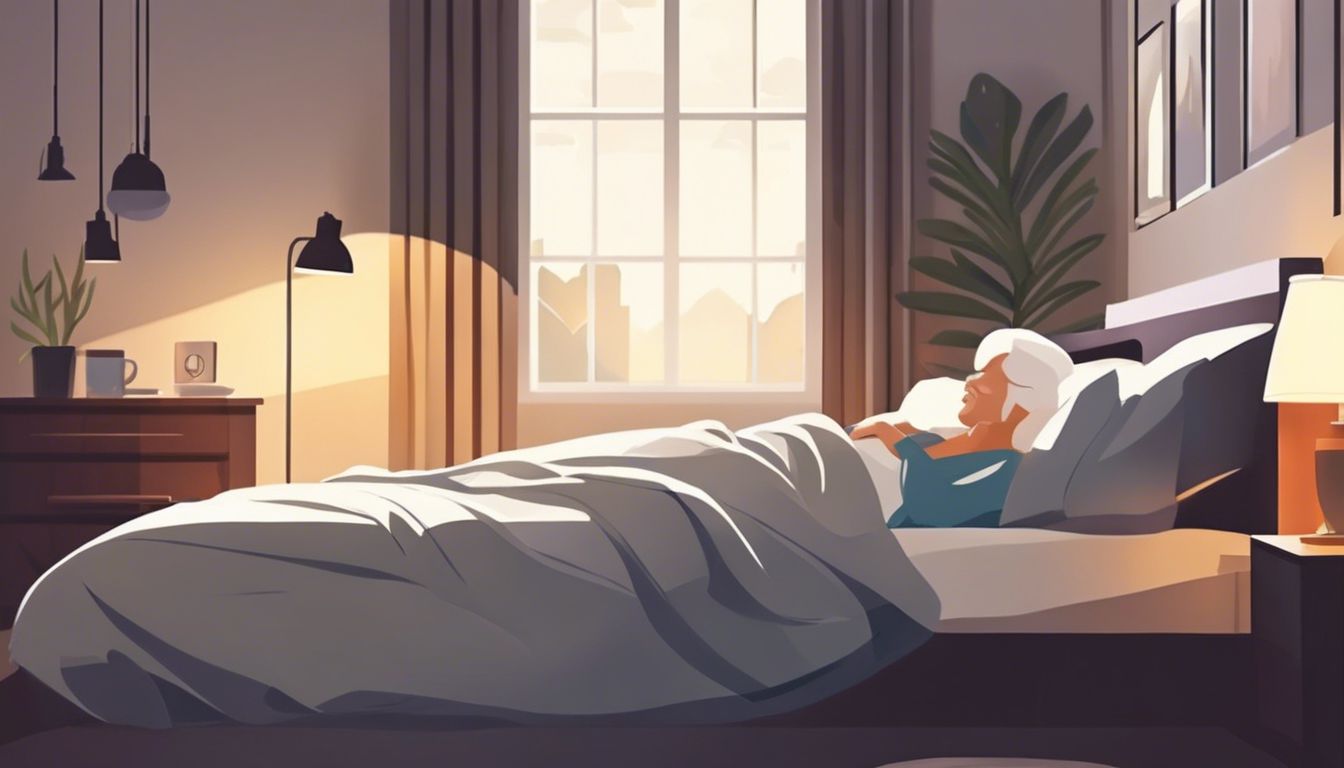Falls at home pose a serious risk for older adults. Each year, 3 million seniors receive emergency treatment for fall injuries. A comprehensive home safety assessment can significantly reduce these risks.
Learn how to conduct a thorough evaluation and make your home safer.
📋✅
- Falls at home are a serious risk for older adults, with 3 million seniors getting emergency treatment for fall injuries each year.
- A home fall risk assessment evaluates an individual’s health, behaviors, and living environment to identify potential hazards, typically costing $150-$200.
- Key areas to evaluate during an assessment include floors, stairways, hallways, bathrooms, bedrooms, kitchens, and outdoor spaces.
- Useful tools for assessments include home safety checklists, fall risk assessment apps, and wearable devices with fall detection technology.
- After an assessment, it’s crucial to follow up on recommendations, implement safety features like grab bars and night lights, and remove tripping hazards to create a safer living environment.
What Is a Home Fall Risk Assessment?

A home fall risk assessment evaluates an individual’s health, behaviors, and living environment to identify potential fall hazards. Healthcare providers order these assessments to prevent falls, which affect 36 million Americans aged 65+ annually.
The process examines floors, stairs, bathrooms, and other areas for safety issues.
Home is where safety begins for older adults.
Typically costing $150-$200, these assessments may be covered by insurance. They differ from aging-in-place assessments, which focus on long-term home modifications for safe independent living.
Fall risk assessments aim to reduce the 1 in 5 falls that result in serious injuries among older adults.
Key Areas to Evaluate During a Home Fall Risk Assessment
A thorough home fall risk assessment covers several key areas in and around the house. These areas include common spaces, functional rooms, and outdoor environments where potential hazards may lurk.
Floors, stairways, and hallways
Floors, stairways, and hallways pose significant fall risks for older adults. Caregivers must focus on these areas to create a safer home environment.
- Secure handrails on both sides of all stairways
- Install bright, glare-free lighting in hallways and on stairs
- Remove clutter and obstacles from walkways
- Fix loose or uneven floorboards promptly
- Secure area rugs with non-slip backing or remove them entirely
- Keep electrical cords against walls, away from foot traffic
- Mark edges of steps with contrasting colors for better visibility
- Install non-slip treads on wooden stairs
- Ensure carpets are firmly attached to stairs and floors
- Place night lights in hallways and stairwells for improved nighttime visibility
Bathrooms
Moving from floors and hallways, we now focus on bathrooms, a critical area for fall prevention. Bathrooms pose unique risks due to slippery surfaces and frequent use.
- Install grab bars near toilets and in showers/tubs
- Use non-slip mats in tubs and on bathroom floors
- Ensure adequate lighting, especially for nighttime use
- Install a handheld shower nozzle for seated bathing
- Consider a raised toilet seat for easier transfers
- Add a sturdy shower chair or tub bench for stability
- Keep frequently used items within easy reach
- Remove area rugs or secure them with non-slip backing
- Install nightlights to improve visibility
- Use contrasting colors for floors and walls to enhance depth perception
Bedrooms
Bedrooms pose unique fall risks for older adults. A comprehensive assessment of this area is crucial for ensuring safety and comfort.
- Install bright lighting with easily accessible switches near the bed
- Place a sturdy nightstand within arm’s reach for essentials like medications, water, and a phone
- Secure loose rugs or remove them entirely to prevent tripping
- Arrange furniture to create clear pathways, especially to the bathroom
- Use a firm mattress at an appropriate height for easy entry and exit
- Equip the bed with bed rails or grab bars if needed for stability
- Keep frequently used items within easy reach to avoid overreaching
- Ensure adequate storage to minimize clutter on floors
- Install smoke alarms and carbon monoxide detectors in the bedroom
- Consider adding a personal emergency response system for quick assistance
Kitchen
The kitchen poses unique fall risks for older adults. Implement these safety measures to reduce hazards:
- Install bright lighting over work areas and near appliances
- Place frequently used items on lower shelves or countertops for easy access
- Use a sturdy step stool with handrails to reach high items safely
- Keep floors clean and dry, wiping up spills immediately
- Remove throw rugs or secure them with non-slip backing
- Install lever-style faucet handles for easier operation
- Use a portable cart to transport heavy or hot items
- Apply non-slip strips on floor areas prone to wetness
- Ensure adequate space between furniture for easy movement
- Use electric appliances with automatic shut-off features
- Store heavier pots and pans in lower cabinets
- Install pull-out shelves in lower cabinets for easier access
- Use contrasting colors on countertop edges to improve visibility
- Place a sturdy chair near food prep areas for seated cooking
Outdoor spaces
Moving from indoor kitchen safety to outdoor spaces, it’s crucial to address potential hazards around the home’s exterior. Outdoor areas present unique fall risks that require specific attention and preventive measures.
- Clear debris and ensure even steps: Remove leaves, branches, and other objects from walkways. Repair or replace uneven or cracked pavement.
- Install grab bars near entrances: Place sturdy handrails by the front door and other exterior entrances for added support.
- Improve lighting on paths and stairs: Install bright, motion-activated lights to illuminate walkways at night.
- Address uneven ground: Fill in holes or dips in the lawn. Level out areas with significant grade changes.
- Secure loose railings: Tighten or replace wobbly handrails on outdoor staircases and porches.
- Apply non-slip materials: Use textured paint or adhesive strips on steps and ramps to increase traction.
- Maintain clear sightlines: Trim bushes and trees near walkways to improve visibility.
- Create a winter safety plan: Stock up on ice melt or sand to treat icy surfaces promptly.
- Consider ramp installation: For homes with steps at entrances, a ramp can provide easier access.
- Inspect outdoor furniture: Ensure chairs and tables are stable and in good repair to prevent tipping.
Other living areas
Living rooms, dining areas, and home offices also require attention during a fall risk assessment. These spaces often contain furniture, electronics, and decorative items that can pose hazards if not properly arranged or secured.
- Remove clutter from walkways and high-traffic areas
- Secure loose cords and wires along walls or under carpets
- Install adequate lighting, including task lighting for reading or working
- Arrange furniture to create clear pathways at least 36 inches wide
- Use nonslip backing on area rugs or remove them entirely
- Place frequently used items within easy reach to avoid stretching or bending
- Ensure sturdy, stable seating with armrests for easy rising
- Install handrails along walls for support when moving between rooms
- Keep remote controls, phones, and other essentials on easily accessible surfaces
- Use cordless phones to reduce tripping hazards from long cords
- Consider installing motion-sensor lights for nighttime navigation
- Secure top-heavy furniture and electronics to walls to prevent tipping
Tools and Resources for Conducting Fall Risk Assessments
Tools like home safety checklists and fall risk assessment apps can help caregivers spot hazards quickly. Read on to learn more about these resources and how they can make your home safer.
Home improvement resources
Several organizations offer valuable home improvement resources for fall prevention. The National Resource Center on Supportive Housing and Home Modifications provides expert guidance on creating safer living spaces.
Rebuilding Together offers free home repairs and modifications for low-income homeowners. State and local governments often run education programs and offer assistance for home modifications.
The National Association of Home Builders maintains a directory of Certified Aging-in-Place Specialists (CAPS) who can assess homes and recommend safety improvements.
Tools to get help
Beyond home improvements, tools for help enhance safety and independence. Emergency response systems provide quick access to assistance. These devices, worn as pendants or wristbands, allow users to call for help with a single button press.
Many smartwatches now include fall detection technology, automatically alerting emergency services if a sudden fall is detected. The Area Agency on Aging offers free home safety assessments, identifying potential hazards and recommending solutions.
These tools give caregivers peace of mind and empower seniors to maintain their independence safely at home.
Latest technologies in wearable devices for fall detection and prevention
Smartwatches now offer advanced fall detection capabilities. These devices use built-in accelerometers and gyroscopes to identify sudden movements indicative of falls. Upon detecting a fall, the smartwatch automatically alerts emergency services or designated contacts.
Some wearables also monitor gait patterns and balance, providing early warnings of increased fall risk.
Specialized fall detection devices have evolved beyond simple pendants. Modern wearables use AI algorithms to distinguish between normal activities and actual falls, reducing false alarms.
These devices often include GPS tracking, two-way communication, and automatic notifications to caregivers. The next section explores the steps to conduct a comprehensive home safety assessment.
Steps to Conduct a Comprehensive Home Safety Assessment
A comprehensive home safety assessment starts with a call to your doctor. Set up a visit to review your health and discuss fall risks specific to your situation.
Make an appointment with your health care provider
Schedule a visit with your healthcare provider to assess fall risks. Medicare Part B covers annual wellness visits that include fall risk evaluations. Your doctor will review medications, discuss any previous falls, and examine your gait.
This appointment helps identify potential hazards and develop personalized prevention strategies.
During the assessment, your provider may recommend assistive devices or physical therapy. They’ll also consider how chronic conditions like osteoporosis or cognitive impairment impact fall risk.
After your appointment, implement the suggested safety measures in your home environment.
Review general safety considerations for each room
General safety considerations for each room form a crucial part of a comprehensive home fall risk assessment. Caregivers should evaluate specific hazards and implement preventive measures in every area of the home. Here’s a room-by-room guide to essential safety checks:
- Living Room:
- Remove clutter and loose rugs
- Secure electrical cords along walls
- Ensure adequate lighting, including night lights
- Install handrails near seating areas
- Kitchen:
- Store frequently used items within easy reach
- Use non-slip mats near sink and stove
- Install good lighting over work areas
- Keep a fire extinguisher easily accessible
- Bedroom:
- Clear pathways around the bed
- Place a lamp and phone within reach of the bed
- Install nightlights for visibility
- Use a bed rail for support if needed
- Bathroom:
- Install grab bars near toilet and in shower/tub
- Use non-slip mats in and outside the shower/tub
- Ensure proper lighting, especially at night
- Consider a raised toilet seat for easier use
- Stairs and Hallways:
- Secure handrails on both sides of stairs
- Ensure proper lighting with switches at top and bottom
- Mark edges of steps with contrasting tape
- Keep stairs clear of objects
- Outdoor Areas:
- Repair uneven walkways and steps
- Install adequate lighting on paths and entrances
- Remove or secure loose gravel or stones
- Keep garden tools and hoses stored properly
Identify and address potential hazards
Identifying and addressing potential hazards is crucial for reducing fall risks in the home. Caregivers play a vital role in creating a safe environment for their loved ones. Here’s a list of key areas to focus on:
- Remove tripping hazards:
- Clear clutter from walkways and stairs
- Secure loose rugs with non-slip backing or tape
- Fix uneven flooring or loose floorboards
- Improve lighting:
- Install bright, easily accessible light switches
- Use nightlights in hallways and bathrooms
- Ensure stairways are well-lit with switches at both ends
- Enhance bathroom safety:
- Install grab bars near toilets and in showers
- Use non-slip mats in bathtubs and shower areas
- Consider a walk-in tub or shower chair for easier access
- Optimize bedroom setup:
- Place a lamp and phone within easy reach of the bed
- Use a bed rail for added support when getting in or out
- Ensure a clear path to the bathroom
- Secure stairways:
- Install handrails on both sides of stairs
- Mark the edges of steps with contrasting tape for visibility
- Keep stairs free from objects and clutter
- Organize the kitchen:
- Store frequently used items at waist level
- Use a sturdy step stool with handrails for reaching high shelves
- Clean up spills immediately to prevent slipping
- Address outdoor hazards:
- Repair uneven walkways and cracked pavement
- Install adequate outdoor lighting
- Keep paths clear of snow, ice, and debris
- Manage electrical cords:
- Secure cords along walls and away from walking areas
- Use cord covers to prevent tripping
- Avoid running cords under rugs or carpets
- Implement assistive technology:
- Consider wearable devices for fall detection
- Install motion sensor lights in key areas
- Use smart home devices for easier control of lights and appliances
- Maintain regular health check-ups:
- Schedule vision and hearing tests
- Review medications for side effects that may increase fall risk
- Discuss balance and strength exercises with a physical therapist
What to Expect During the Assessment Process
During a home safety assessment, an expert will walk through your house. They’ll check for hazards and suggest fixes to prevent falls.
What happens during an aging-in-place assessment
An aging-in-place assessment evaluates a home’s safety and accessibility for older adults. Occupational therapists or healthcare professionals inspect each room, identifying potential hazards and recommending modifications.
They assess flooring, lighting, furniture placement, and bathroom fixtures to reduce fall risks. The assessment also considers the individual’s mobility, balance, and cognitive abilities.
Assessors provide guidance on safety equipment like grab bars, non-slip mats, and improved lighting. They may suggest home improvements such as widening doorways or installing ramps.
The assessment results in a detailed plan for creating a safer living environment. Costs vary, with some local agencies offering free services. Follow-up visits ensure implemented changes effectively support aging in place.
What to expect during a home fall risk assessment
During a home fall risk assessment, a healthcare professional evaluates your living space for potential hazards. They inspect floors, stairs, lighting, and bathroom safety features.
The assessor examines your mobility, balance, and ability to perform daily tasks. They may ask about your medical history, medications, and recent falls.
The assessment typically takes 1-2 hours. The evaluator provides a detailed report with specific recommendations for home modifications and fall prevention strategies. These might include installing grab bars, improving lighting, or removing tripping hazards.
The cost ranges from $150 to $200, with possible insurance coverage. Medicare may cover therapy visits for in-home assessments by occupational or physical therapists. Simple home modifications could reduce falls among older adults by 40%.
The next step involves implementing the recommended changes to create a safer living environment.
After the Assessment: Implementing Recommendations
Implementing recommendations after a home safety assessment is crucial. Follow up on the suggested changes and use resources like grab bars or non-slip mats to improve safety.
How to follow up on assessment recommendations
Following up on assessment recommendations is crucial for improving home safety. Caregivers play a key role in implementing suggested changes and monitoring progress.
- Schedule follow-up visits with healthcare providers to track improvements and adjust plans.
- Create a checklist of recommended modifications, prioritizing high-risk areas like bathrooms and stairs.
- Install safety devices such as grab bars, non-slip mats, and improved lighting in key areas.
- Remove tripping hazards like loose rugs, clutter, and exposed cords throughout the home.
- Ensure proper medication management to reduce fall risks associated with side effects.
- Encourage regular exercise and physical therapy to improve strength and balance.
- Invest in assistive devices like walkers or canes as recommended by occupational therapists.
- Implement a home monitoring system or wearable device for fall detection and quick response.
- Address incontinence issues to reduce nighttime fall risks during bathroom trips.
- Maintain regular vision and hearing check-ups to address sensory impairments.
- Educate family members and caregivers on proper transfer techniques and fall prevention strategies.
- Conduct periodic home safety reassessments to identify new risks or needed adjustments.
Resources and products to help older adults age in place
Numerous products enhance safety for older adults at home. Grab bars in bathrooms, non-slip mats for showers, and raised toilet seats reduce fall risks. Stairlifts and ramps improve mobility between floors.
Smart home devices like voice-activated lights and thermostats increase convenience. Medical alert systems provide quick access to emergency services. Occupational therapists can recommend specific aids tailored to individual needs.
Medicare and some private insurance plans may cover certain home modifications or assistive devices. The National Falls Prevention Resource Center offers guides on selecting appropriate equipment.
Conclusion
Home safety assessments reduce fall risks for older adults. Evaluate each room for potential hazards. Install safety features like grab bars and night lights. Remove tripping hazards such as loose rugs.
Regular assessments keep homes safe as needs change. Implement recommended changes promptly to prevent accidents.
Discover the cutting-edge solutions for enhancing safety with our guide on the latest technologies in wearable devices for fall detection and prevention.
FAQs
1. What are key areas to check in a home safety assessment?
Check smoke detectors, fire extinguishers, and nonslip mats. Ensure proper lighting and remove tripping hazards. Assess the need for a walk-in tub or wheelchair accessibility.
2. How can I reduce fall risks for someone with cognitive impairments?
Install a security system and use cognitive training exercises. Consult an occupational therapist for person-environment fit strategies. Consider a medical alert system for emergencies.
3. What role does physical activity play in fall prevention?
Regular exercise, like tai chi, improves balance and strength. Vitamin D supplements can help bone health. Consult a doctor before starting new activities.
4. How often should I conduct a home safety assessment?
Perform assessments quarterly or after health changes. Update fire drills and check medical equipment regularly. Review Medicare plans for coverage of home modifications.
5. What professionals can help with a home safety evaluation?
Occupational therapists, clinical social workers, and insurance agents can assist. They provide expertise on risk factors, ADLs, and coverage for safety improvements.
6. How do medical conditions impact home safety needs?
Conditions like Alzheimer’s or low vision require specific safety measures. Consult healthcare providers about medication side effects and fall risks. Address issues like bladder control to prevent nighttime falls.









